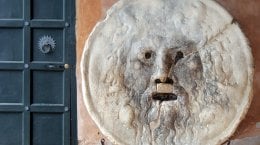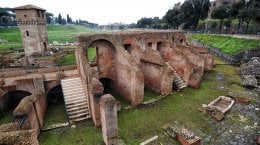Official Reseller Rome and Vatican – Jubilee 2025
Colosseum
The Flavian Amphitheater, better known as the Colosseum, is considered one of the wonders of the world. Located in the center of Rome, it is the largest amphitheater in the world.

The Flavian Amphitheater, better known as the Colosseum, is considered one of the wonders of the world. Located in the center of Rome, it is the largest amphitheater in the world.
The birth of the Colosseum
The Colosseum found its origins in A.D. 72 after the Emperor Vespasian decided to build a place to play the famous gladiator games. After his death, Tito completed the work by adding the third and fourth order that served to complete the two floors already built.
The work was finished thanks to Vespasian’s second son, the Emperor Domitian, who implemented some modifications and embellishments to the whole structure, such as the arena’s basements and bronze decorations.
The Colosseum was inaugurated at the end of its construction and, for the occasion, games were played for a hundred consecutive days. The name of the Amphitheater has the particularity of remembering the huge bronze statue of Nero which, given its considerable size, is called the Colossus of Nero.
Where the Colosseum is located
The Colosseum is located in the center of Rome, east of the Roman Forum. It is only a few minutes’ walk for those arriving from the Imperial Forums, Piazza Venezia or the most famous streets of the capital, such as Via del Corso and Via del Campidoglio. Due to its central position, the Amphitheater is easily reachable by various means. First of all, you can opt for an open tour. In this case, you will need to go to specific agencies to book a ticket including transport and entrance to the attraction.
Those arriving in Rome by train have the option of taking the Metro Line B directly from the station, which stops right in front of the Colosseum.
Finally, various buses that depart from various points in the city and have the same last stop in front of the Amphitheater can be used. This method is not recommended during high season as the vehicles can be very full.
On Sunday, Via dei Fori Imperiali and Piazza del Colosseo are closed to car traffic but open to people on foot and by bike.
How was The Colosseum made
The Colosseum looks like a big ring. The structure, made of square travertine blocks, has a height of 56 meters spread over four floors. The first three floors are made with arches that show different semi-columns depending on the level. The first level has Tuscan capitals, the second Ionic and the third Corinthians. The fourth floor is in full masonry and divided into eighty squares with a total of forty windows. The holes applied in the cornice are visible from each square; these were necessary to support wooden beams used as a support base for the velarium, namely the sheet used to protect the spectators from atmospheric aggression.
The architectural work is made up of eighty radial walls that start from the entrance up to the arena surrounded by five tiers of terraces where sixty thousand spectators could sit having defined seats according to their class. The latter was also a distinctive feature for identifying the entrances. Indeed, there were different entries according to the class; those destined for important personalities had precious details such as stucco decorations with figures.
Above the arena there was a tribune that was built in marble and adorned with velvets, which represented the podium for the emperor and his family. The arena has a layer of yellow sand stretched over huge planks that were used to hide the apogees, that were the metro channels used as warehouses, deposits and as an animal shelter.
The arena has a size of 76 by 46 meters and, during the games, a wire mesh was placed as a security system against attacks from tigers and lions. The arena has two entrances, one intended for the passage of gladiators, the Porta Triumphalis, and the other used as a service passage to take away the corpses of the fighters, called Porta Libitinaria, in memory of the goddess Libitina, protector of the tombs.
When the games involved the use of ferocious animals, they were passed through narrow and small corridors that led to huge elevators through which the beasts were hoisted into the arena.
The interior of the Colosseum shows how the various sectors highlighted the class to which they belonged. The first sector, intended for political personalities, consisted of large shelves above which there were seats. This area was accessed thanks to the passage on a ramp that ended with a solid barrier placed on the whole ring that was used to guarantee the protection and safety of the spectators.
The second sector is also called the first balcony and includes a circular shelf and an internal corridor.
There are eight tiers in this sector. The second balcony, namely the third level, has a landing and represents the part with the greatest number of seats. This serves as the basis for the third balcony, which is located on the fourth level.
The whole amphitheater has some obligatory paths that allowed people to reach their sector of belonging. The construction of the Amphitheater was quite fast for that time, about eight years, and modern techniques were used. Some modular elements were in fact produced outside the yard, to be immediately placed in the right area.
What to visit around the Colosseum
Along with the Colosseum, additional structures that can be viewed were built. Among these, there are the Magnus, a structure that housed the gladiators during their training, the Armamentarias, weapons and equipment storage rooms, and the sanatorium, used to treat the wounds of the combatants.
Being in a central area, the Amphitheater is close to other places that can be visited. Moving on foot you can get to famous squares such as Piazza Venezia and Piazza di Spagna. A little further away but still within walking distance there is Piazza Navona, the Trevi Fountain and the Pantheon.
The beautiful Basilica of St. Clemente and the Basilica of St. Peter should not be underestimated.
One of the most beautiful places in the capital is the memory of the Roman Forum and the Capitol.
Finally, those who have enough time at their disposal should consider the idea of visiting the phenomenal Vatican Museums.
08.30 a.m. – 4.30 p.m.: until February 15
08.30 a.m. – 5.00 p.m.: from February 16 to March 15
08.30 a.m. – 5.30 p.m.: from 16 March to the last Saturday of March
08.30 a.m. – 7.15 p.m.: from the last Sunday of March to August 31
08.30 a.m. – 7.00 p.m.: from September 1 to September 30
08.30 a.m. – 6.30 p.m.: from October 1 until the Saturday last October
In general, the Colosseum is open from 09:00 a.m. to an hour before sunset.
It is possible to access the monument up to an hour before closing.
The monument is closed on December 25, January 1 and May 1.
It is open on December 24 and 31.
Metro
Line A direction Battistini, Ottaviano Metro Station or Cyprus Metro Station
Bus
Bus n.49, stops in front of the Vatican Museums
Bus n.32, n.81, n.982, Piazza del Risorgimento stop
Bus n.492, n.990, Via Leone IV / Via degli Scipioni stop
Tram
Tram n.19, Piazza del Risorgimento stop
Taxi
Station square in front of the Vatican Museums
Check the stops of the Open Top Bus Vatican & Rome on the map in order to find the closest stop to the attraction you are interested in visiting;
Alternatively, consult https://www.google.com/maps for information on public transport.
Remember: with Omnia 72h you have access to all means of public transport of Rome.





